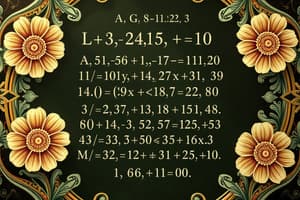Podcast
Questions and Answers
What is a variable?
What is a variable?
A value, usually in the form of a letter or symbol, that can change or that represents an unknown quantity.
What does it mean to simplify an expression?
What does it mean to simplify an expression?
To perform all the indicated operations means to simplify an expression.
What is an equation?
What is an equation?
A relation that shows that one expression is equal to another expression.
What is indirect measurement?
What is indirect measurement?
What is a formula?
What is a formula?
What is a rate?
What is a rate?
What is a unit rate?
What is a unit rate?
What is a coefficient?
What is a coefficient?
What is the order of operations?
What is the order of operations?
What is a conversion factor?
What is a conversion factor?
What is output in terms of variables?
What is output in terms of variables?
Multiplicative inverses are also called ______________.
Multiplicative inverses are also called ______________.
What is a proportion?
What is a proportion?
What is a constant?
What is a constant?
What is the distributive property?
What is the distributive property?
What does the associative property of multiplication state?
What does the associative property of multiplication state?
What does the commutative property of multiplication indicate?
What does the commutative property of multiplication indicate?
What does the associative property of addition imply?
What does the associative property of addition imply?
What is the simplified result of the expression 2x+y+4-3y+4+x?
What is the simplified result of the expression 2x+y+4-3y+4+x?
Simplify the expression (6-1)a+9b-(2+2)a+10.
Simplify the expression (6-1)a+9b-(2+2)a+10.
What is the solution to the equation 2x+3x-4 = x+6?
What is the solution to the equation 2x+3x-4 = x+6?
What is the solution to the equation 2x-5 = x+1?
What is the solution to the equation 2x-5 = x+1?
Determine the number of children age 5 in a kindergarten class if 80% of a class of 20 children are that age.
Determine the number of children age 5 in a kindergarten class if 80% of a class of 20 children are that age.
If a car makes a trip of 422 miles in 8 hours, what is its average speed?
If a car makes a trip of 422 miles in 8 hours, what is its average speed?
If there are 12 inches in a foot, how many inches are in 64 feet?
If there are 12 inches in a foot, how many inches are in 64 feet?
Flashcards are hidden until you start studying
Study Notes
Variables and Expressions
- A variable represents an unknown quantity and is usually expressed as a letter or symbol.
- Simplifying an expression involves performing all indicated operations to reduce it to its simplest form.
Equations and Measurements
- An equation signifies equality between two expressions.
- Indirect measurement uses formulas or proportions to determine an object's measurement.
Mathematical Relationships
- A formula articulates a mathematical rule or relationship through equations.
- A rate compares the change of one quantity to another, while a unit rate standardizes this to one unit of the second quantity.
Algebraic Components
- A coefficient shows the product of a number and a variable within a term.
- Reciprocals, or multiplicative inverses, refer to two numbers whose product equals one.
Properties and Operations
- The Order of Operations provides rules for performing multiple operations in a specific sequence.
- The Distributive Property allows multiplication across a sum, transforming expressions like 5(7+2) into 5x7 + 5x2.
Associative and Commutative Properties
- The Associative Property of Addition and Multiplication states that the grouping of numbers does not affect their sum or product.
- The Commutative Property of Multiplication indicates that the product remains unchanged regardless of the order of factors.
Constants and Proportions
- A constant remains unchanged regardless of other variables in an equation.
- A proportion equates two ratios, affirming their equality.
Problem Solving and Answers
- Expressions can be simplified, such as transitioning 2x + y + 4 - 3y + 4 + x into 3x - 2y + 8.
- Solutions can be derived from equations like 2x + 3x - 4 = x + 6, yielding x = 2.5.
- Word problems can involve proportions for real-life applications, such as determining the number of children aging 5 in a class based on percentages or calculating average speed from distance and time.
Sample Solutions
- For the expression (6-1)a + 9b - (2+2)a + 10, the simplified form is a + 9b + 10.
- A car traveling 422 miles in 8 hours moves at an average speed of approximately 52.75 mph.
- Converting 64 feet to inches results in 768 inches using the conversion factor of 12 inches per foot.
Studying That Suits You
Use AI to generate personalized quizzes and flashcards to suit your learning preferences.




